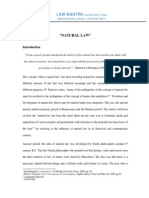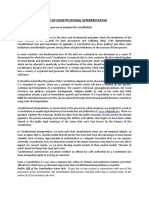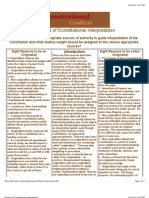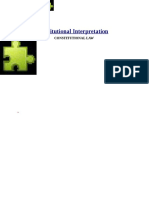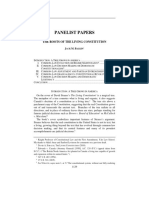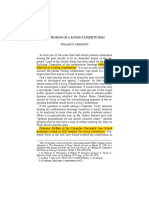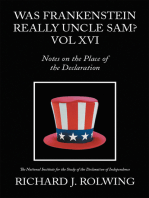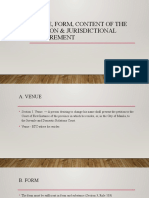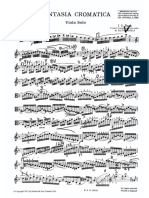Interpretation of Constitutions: A Doctrinal Study: - Arvind P. Datar & Rahul Unnikrishnan
Interpretation of Constitutions: A Doctrinal Study: - Arvind P. Datar & Rahul Unnikrishnan
Uploaded by
Nidhi PillayOriginal Description:
Original Title
Copyright
Available Formats
Share this document
Did you find this document useful?
Is this content inappropriate?
Report this DocumentCopyright:
Available Formats
Interpretation of Constitutions: A Doctrinal Study: - Arvind P. Datar & Rahul Unnikrishnan
Interpretation of Constitutions: A Doctrinal Study: - Arvind P. Datar & Rahul Unnikrishnan
Uploaded by
Nidhi PillayCopyright:
Available Formats
Interpretation of Constitutions:
A Doctrinal Study
—Arvind P. Datar & Rahul Unnikrishnan1
Hans Kelsen perceives a ‘Constitution’ as an idea of the highest order that
determines the whole legal and political order of a country- a template for legal
distribution of political power amongst its constituent units. This means that the
Constitution determines the genesis of statutes, determination of the organs and
the procedure of legislation. The idea that the basic rule of the Constitution forms
the foundation of all orders of the State and is thereby required to be as firm and
unchangeable as possible, invariably leads to the view that it is necessary to dif-
ferentiate between constitutional norms and statutory norms.2
When the text of the Constitution is unambiguous, its sounds can be easily
interpreted. However, when the Constitution is silent on any right, immunity,
privilege or any form of distribution of power, it becomes an exercise to interpret
the ‘sound of the silence’. Laurence H. Tribe has eloquently dealt with silences of
Constitutions in the undernoted article.3
Craig Ducat argues that the various modes of constitutional interpreta-
tion are concerned not only with addressing how the practice of judicial review
is to be harmonized with democratic institutions, but also with the procedure
that standard courts should use to determine whether a given legislative, exec-
utive, administrative or judicial action contravenes the Constitution. According
to Ducat, constitutional interpretation is carried on through several alternative
modes of judicial review that address the logical interconnection among the fol-
lowing three elements: the justification for the power to review, the standard of
constitutionality to be applied by the courts, and the method by which judges
support the conclusion that a given governmental action does or does not violate
1
Advocates, Madras High Court. An abridged version of this essay was presented by Mr. Datar at
the National Judicial Academy on 4 February, 2017. The authors acknowledge the contribution of
Sarangan Rajeshkumar, a IV year student of National Law School of India University, Bangalore.
2
Lars Vinx, The Guardian Of The Constitution: Hans Kelsen And Carl Schmitt On The Limits Of
Constitutional Law, 28 (Cambridge University Press, 2015).
3
Laurence H. Tribe, Soundings and Silences, 115 Michigan Law R eview, Vol. 115 (2016), http://
michiganlawreview.org/wpcontent/uploads/2016/11/115Mich.L.Rev_Online26_Tribe.pdf.
Published in Articles section of www.manupatra.com
Vol. 29 Interpretation of Constitutions 137
the Constitution.4 In most Constitutions, the concept of judicial review forms a
great silence. Further, constitutional interpretation is different from statutory or
common law interpretation because of the general and open-ended nature of the
language used in Constitutions. Furthermore, the text of Constitutions is of an
ancient origin and it concerns topics that are central to a country’s basic political
structures and values.5 These factors have helped develop a distinct set of consti-
tutional interpretative techniques that require in-depth study and careful analysis.
This distinction between constitutional interpretation and statutory interpretation
was further highlighted by Chief Justice Dickson of the Canadian Supreme Court
in the following words-
“The task of expounding a constitution is crucially differ-
ent from that of construing a statute. A statute defines pres-
ent rights and obligations. It is easily enacted and as easily
repealed. A constitution, by contrast, is drafted with an eye to
the future. Its function is to provide a continuing framework for
the legitimate exercise of governmental power and, when joined
by a Bill or a Charter of rights, for the unremitting protec-
tion of individual rights and liberties. Once enacted, its provi-
sions cannot easily be repealed or amended. It must, therefore,
be capable of growth and development over time to meet new
social, political and historical realities often unimagined by its
framers. The judiciary is the guardian of the Constitution and
must, in interpreting its provisions, bear these considerations in
mind.”6
I. THEORIES OF CONSTITUTIONAL INTERPRETATION
A. Textualism
The “textualist” theory or the “plain meaning” theory of interpretation is,
according to Robert Post, not a theory at all; it is nothing but a description of
what happens when the meaning of the constitutional text is not problemat-
ic.7 This approach was championed by Justice Scalia of the Supreme Court of
the United States and Judge Easterbrooke of the United States Court of Appeal
for the Seventh Circuit.8 Both Justice Scalia and Judge Easterbrooke emphasize
the need to imagine a ‘reasonable reader’ whose mission is to find out “what
4
Craig R. Ducat, Constitutional Interpretation, 80 (Thomson West, 2004).
5
Kent Greenawalt, Statutory and Common Law Interpretation, 293 (Oxford University Press,
2013).
6
Hunter v. Southam Inc., 1984 SCC OnLine Can SC 36 : (1984) 2 SCR 145.
7
Robert C. Post, Theories of Constitutional Interpretation, 30 Faculty Scholarship Series 13, 14
(1990).
8
Caleb Nelson, What is Textualism, 91(2) Virginia Law R eview 347, 347-418 (2005).
Published in Articles section of www.manupatra.com
138 National Law School of India Review 29 NLSI R ev. (2017)
Congress meant by what it said”.9 In short, textualists advocate that interpretation
should focus upon what the text would reasonably be understood to mean, rather
than upon what it was intended to mean.10 Kent Greenawalt observes that there
are two underlying claims that are contained here: the true nature of a statute or
constitution is contained exclusively in its language, and the actual mental states
of legislators are irrelevant.11
The textualists’ dislike for legislative history is well-known.12 Max Radin,
an erstwhile legal realist, severely criticizes the idea of using legislative intent
in statutory and constitutional interpretation.13 The arguments put forth by Max
Radin were based on common sense and pure logic. He borrowed ideas from the
book Logic written by W.E. Johnson to challenge the assumption that hundreds
of legislators may share a common legislative intent. He wrote:
“The chances that of several hundred men each will have
exactly the same determinate situations in mind as possible
reductions of a given determinable, are infinitesimally small.
The chance is still smaller that a given determinate, the liti-
gated issue, will not only be within the minds of all these men
but will be certain to be selected by all of them as the pres-
ent limit to which the determinable should be narrowed. In an
extreme case, it might be that we could learn all that was in the
mind of the drafts- man, or of a committee of half a dozen men
who completely approved of every word. But when this draft is
submitted to the legislature and at once accepted without a dis-
sentient voice and without debate, what have we then learned of
the intentions of the four or five hundred approvers? Even if the
contents of the minds of the legislature were uniform, we have
no means of knowing that content except by the external utter-
ances or behaviour of these hundreds of men, and in almost
every case the only external act is the extremely ambiguous one
of acquiescence, which may be motivated in literally hundreds
of ways, and which by itself indicates little or nothing of the
pictures which the statutory descriptions imply. It is not impos-
sible that this knowledge could be obtained. But how probable it
is, even venturesome mathematicians will scarcely undertake to
compute.”14
9
Ibid at 354.
10
Antonin Scalia, A Matter of Interpretation: Federal Courts and the Law, 144 (Princeton
University Press, 1997).
11
Greenawalt, supra note 5, at 44.
12
John F. Manning, Textualism as a Non-Delegation Doctrine, 97(3) Columbia Law R eview 673
(1997).
13
Max Radin, Statutory Interpretation, 43(6) H arvard Law R eview 863 (1930).
14
Id, at 869 (Radin uses W.E. Johnson’s theories, especially on his differentiation of ‘determi-
nables’ and ‘determinates’, to observe that the situation described in a statute is generally a
Published in Articles section of www.manupatra.com
Vol. 29 Interpretation of Constitutions 139
On a semantic level, while agreeing with Max Radin, we believe that there is
certainly some merit in saying that a legislature has no intention in connection
with words which some two or three men drafted, which a considerable num-
ber rejected, and in regard to which many of the approving majority might have
had different ideas and beliefs. However, this does not mean that other theories
of interpretation are fallacious. Certainly, the textualist theory of interpretation
is the one with the least scope for imagination, thereby curtailing judicial discre-
tion. One should also keep in mind the fact that a constitution is always a ‘living
document’.
B. Originalism15
Originalism is the view that the Constitution should be interpreted accord-
ing to its original meaning.16 This school of thought came to the fore with the
arguments of Herbert Wechsler on neutral principles to guide constitutional
interpretation.17 In his article in the Harvard Law Review, Wechsler argues that
the courts should practice constraint on adjudication i.e., the grounds for deci-
sions must be neutral and general. Criticising the decision in Brown v. Board of
Education,18 Wechsler observed that courts must choose principles which they are
willing to apply neutrally to all cases that may fairly be said to fall within them,
which, in his opinion, were essential if the Supreme Court was not to be a naked
power organ.
In 1971, Judge Robert Bork, then a professor at Yale Law School, argued
that the neutral principles as postulated by Wechsler should be derived from the
Constitution itself.19 Articulating further, Bork, in his seminal book The Tempting
of America, observes that when a judge finds his principle in the Constitution as
originally understood, the problem of the neutral derivation of principle is solved
and he/she need not make unguided value judgments of his own. This was con-
sidered as a safeguard against political judging.20
determinable; that is to say, it is a statement which involves a number of possible events or indi-
vidualizations, any one of which would be correctly described by that determinable. Further, a
determinable of this sort can be made more nearly determinate by reducing the number of possi-
ble individualizations, and it becomes quite determinate when it is so expressed that there is only
one).
15
Also known as ‘interpretivism’/‘preservativism’.
16
John O. McGinnis & Michael B. Rappaport, Originalism and the Good Constitution, 1 (Harvard
University Press, 2013).
17
Robert M. Howard & Jeffrey A. Segal, An Original Look at Originalism, 36(1) Law and Society
R eview 113, 113-118 (2002); Herbert Wechsler, Toward Neutral Principles of Constitutional Law,
73(1) H arvard Law R eview, 1-35 (1959).
18
Brown v. Board of Education, 1954 SCC OnLine US SC 44 : 98 L Ed 873 : 347 US 483 (1954)
(in this case the Supreme Court declared state laws establishing separate public schools for black
and white students to be unconstitutional).
19
Harry H. Wellington, Interpreting the Constitution, 44 (Yale University Press, 1990).
20
Robert H. Bork, The Tempting of America: The Political Seduction of Law, 146 (Touchstone,
1990).
Published in Articles section of www.manupatra.com
140 National Law School of India Review 29 NLSI R ev. (2017)
Jeffrey Goldsworthy identifies eight propositions about the nature of
Constitutions and the rule of law that support the originalist school of interpreta-
tion.21 They are:
1. A Constitution necessarily has a meaning prior to judicial interpretation of
it;
2. To change the meaning of a law is to change the law;
3. The original meaning of a Constitution is its “utterance meaning,” which
must be distinguished from its original literal meaning and its originally
intended meaning;
4. Constitutional amending formulas bind judges as well as other officials
and preclude change through judicial interpretation;
5. Change to the constitution through interpretation undermines the
Constitution, the rule of law, the principle of democracy, and the principle
of federalism;
6. Judges are duty-bound to determine and clarify the pre-existing meaning
of the Constitution but can supplement that meaning when it is not suffi-
ciently determinate to resolve the problem at hand.
7. Although judges cannot deliberately change the Constitution, constitu-
tional law can and does legitimately evolve over time; and
8. Consistent application of any constitutional theory, including originalism,
might lead to grave injustice in a particular case and if it does, judges
might be morally bound to disobey the Constitution, but this has nothing
to do with the true meaning of the Constitution.
However, it must be stated that originalists have faced serious objections from
academicians. The main criticisms are that the original understanding is unknow-
able, the Constitution must change as society changes and that there is no real
reason for the living to be governed by the dead.22 In our opinion, the origi-
nalist theory of interpretation should be read in a restricted manner. An origi-
nalist interpretation of distribution of powers and other ‘basic structures’ of a
Constitution helps the Constitution survive but an originalist interpretation of the
rights of individuals which results in a narrow interpretation of rights cannot be
justified in any manner whatsoever.
21
Jeffrey Goldsworthy, The Case for Originalism, The Challenge of Originalism: Theories of
Constitutional Interpretation, 42, 42-69 (Grant Huscroft & Bradley W. Miller eds, Cambridge
University Press, 2011). (According to Goldsworthy, utterance meaning is the full meaning of an
utterance, implied as well as expressed, and it depends on what the speaker’s meaning appears
to be, given evidence that is readily available to his or her intended audience, including the sen-
tence meaning of the utterance and other clues such as its context).
22
Bork, supra note 20, at 161.
Published in Articles section of www.manupatra.com
Vol. 29 Interpretation of Constitutions 141
C. Doctrinalism
The Doctrinalist approach involves resolving contemporary constitutional con-
troversies by interpreting past precedents. The focus of this school of thought
is the idea that the principle underlying a past decision provides the standard
for interpreting the Constitution in future cases. Mark Graber provides a sim-
ple example to demonstrate this thought: if constitutional decision-makers have
declared that the Constitution protects the right to burn the flag of the United
States (U.S.), then the same principle should unequivocally compel constitu-
tional decision-makers to declare that the Constitution protects the right to burn a
map of the United States or the state flag of Texas. He also quotes Justice Oliver
Wendell Holmes, who emphasised how precedential reasoning allowed the law to
develop and grow over time as judges applied, extended and adjusted legal princi-
ples when new cases arose. Further, constitutional precedents may be established
by judges, presidents or legislators.23 Needless to say, these can also be overruled
or altered if they are found to be erroneous or do not meet the felt necessities of
the time.
D. Structuralism
Structuralists use the overall constitutional arrangement of offices, powers, and
relationships or rather “the meaning of the Constitution as a whole”, to solve hard
cases. The U.S. Constitution’s leading structural principles are federalism, separa-
tion of powers and democracy24 even though none are stated explicitly in the con-
stitutional text.25 Charles Black, the main proponent of structuralism, maintains
that structuralism provides an “inference from the structures and relationships
created by the constitution in all its parts or in some principal part” rather than
an “exegesis of a particular textual passage”.26 In doing so, a structuralist refuses
to answer questions concerning the origin of law, the legislative intent or the con-
sequences and concerns himself only with the relationship that exists among legal
texts. The structuralist sees laws only as signs that in turn refer to other signs.27
In doing so, the structuralist sets aside any arguments made to justify the exist-
ence of laws or to criticize them.
In this way, structuralist thinking flattens out legal norms, principles and laws
into a single system that works in perfect synchrony and is internally consistent
23
Mark A. Graber, A New Introduction to American Constitutionalism, 80 (Oxford University
Press, 2013).
24
Sotirios A. Barber & James E. Fleming, Constitutional Interpretation: The Basic Questions, 117
(Oxford University Press, 2007).
25
Graber, supra note 23, at 81.
26
Graber, supra note 23, at 81.
27
David Kennedy, Critical Theory, Structuralism and Contemporary Legal Scholarship, 21(2) New
England Law R eview (1985).
Published in Articles section of www.manupatra.com
142 National Law School of India Review 29 NLSI R ev. (2017)
in its object. All parts of the system are assumed to be consistent with each other
in the meanings accorded to each of them by the legal language.
The structuralist also firmly believes in the law’s ability to provide answers
to any legal issues that may arise and searches within the system to identify lan-
guage that is capable of being mutated to accommodate situations while contin-
uing to retain the legal character that it is endowed with. The system itself is
merely a diagram that is made up of different connectors that take the shape of
legal concepts, which connect laws that exist in different forms (statutes, rules,
precedents, etc.). It is these relationships that are presented to us in permutations
of ‘rights’, ‘duties’, ‘liabilities’, ‘powers’ and so on.
E. Prudentialism
Prudentialists determine constitutional meanings by examining the costs and
benefits of different policies.28 Justice Robert Jackson famously said, “if the
Court does not temper its doctrinaire logic with a little practical wisdom, it will
convert the constitutional Bill of Rights into a suicide pact”.29 Taking a differ-
ent view, Justice Scalia held that a judicial decision granting habeas corpus to
alleged terrorists detained at Guantanamo Bay would almost certainly cause more
Americans to be killed.30
The prudentialist has the unique distinction of being able to appeal to the pub-
lic sense of conscience as opposed to a textualist, who is seen as an unfeeling
and stoic individual. Moreover, a prudentialist also lies in stark contrast to an
originalist who looks back upon legislative history to interpret laws. A pruden-
tialist instead, focuses on the present rather than the past since the latter is in the
opposite direction of progress. Although one might argue with the prudentialist
that laws have been framed keeping in mind their future implications, the rebut-
tal for this argument would be that there is considerable complexity in applying
them to today’s society and consequently, it is necessary to look for new solutions
to the problem at hand. The primary motivation of prudentialist legal reasoning is
to arrive at conclusions that do not appear to be senseless to society at large. The
strength of prudentialism lies in its emotional appeal. It imparts a human touch
to legal interpretation making it easily understandable for those who have viewed
law as an unapproachable enterprise. It achieves this by stating its object to be
the balancing of costs and benefits of a particular rule rather than strict adherence
to legislative intent or even to the text of the law.31
28
Graber, supra note 23, at 83.
29
Terminiello v. City of Chicago, 1949 SCC OnLine US SC 59 : 93 L Ed 1131 : 337 US 1 (1949).
30
Boumediene v. Bush, 2008 SCC OnLine US SC 46 : 171 L Ed 2d 41 : 553 US 723 (2008).
31
Jack M. Balkin, Constitutional Grammar, Yale Law School Faculty Repository (1994) http://digi-
talcommons.law.yale.edu/fss_papers/269.
Published in Articles section of www.manupatra.com
Vol. 29 Interpretation of Constitutions 143
F. Purposive Interpretation
Aharon Barak, a former President of the Supreme Court of Israel, is the main
proponent of the doctrine of purposive interpretation. He observed that purposive
interpretation demonstrates its sensitivity to the uniqueness of a Constitution in
the balance it strikes between subjective purpose i.e., the intent of the authors
of the Constitution, and objective purpose i.e., the intent of the system.32 Barak
cites the Canadian Supreme Court33 which used the doctrine of purposive inter-
pretation to observe that the meaning of a right or freedom under the Charter
of Rights and Freedoms must be ascertained by an analysis of the purpose of
such a guarantee. Purposive interpretation can thus be a perfect tool of inter-
pretation for an expansive interpretation of rights owing to the felt necessities of
time but at the same time without deviating from the core principles that shape a
Constitution.
According to Barak, the subjective purpose of a Constitution is the goals,
interests, values, aims, policies and function that the founders of the Constitution
sought to actualize. If credible historical information about it exists, then the
judges can easily identify them.34 On the other hand, the objective purpose of a
Constitution is the interests, goals, values, aims, policies and function that the
constitutional text is designed to actualize in a democracy. The focus of his argu-
ment is that a democratic legal system’s values and principles shape the objective
purpose of its Constitution. He says that the constitutional text tightly binds its
objective purpose in two ways: first, the essence of a Constitution’s objective pur-
pose may arise from its language; and secondly, one cannot use the Constitution
to achieve a purpose that its language cannot bear.35
II. CONSTITUTIONAL INTERPRETATION-
THE INDIAN PERSPECTIVE
Unlike in the U.S., it is difficult, if not impossible, to discern the doctrinaire
studies on different schools of constitutional interpretation in India. The U.S.
Constitution is substantially silent on many issues or ‘sounds’, as we call it, or the
same have been often provided in general terms. For instance, the expression ‘due
process’ has been the subject matter of extensive judicial comment. Similarly, as
David Derham puts it, the U.S. constitution is ‘silent’ on many other issues like
‘trade and commerce’.36 He further argues that, and rightly so, the Australian
and Indian Constitutions were drafted with great particularity and that the courts
32
Aharon Barak, Purposive Interpretation in Law, 371 Princeton University Press, 2005).
33
R. v. Big M Drug Mart Ltd., 1985 SCC OnLine Can SC 16 : (1985) 1 SCR 295.
34
Barak, supra note 32, at 375.
35
Barak, supra note 32, at 377.
36
David P. Derham, Some Constitutional Problems arising under Part XIII of the Indian
Constitution, 1 Journal of Indian Law Institute, 523, 562 (1959).
Published in Articles section of www.manupatra.com
144 National Law School of India Review 29 NLSI R ev. (2017)
should avoid reasoning with statesman-like speculations. He was very critical
about the interpretation of Part XIII37 of the Indian Constitution. He said-
“Part XIII is an example of such particularity and, it is sug-
gested, the courts have been permitted by that Part to behave
like mere lawyers and have not been required to assume the
larger role except in the traditional interstitial way.”38
Further, it is often a forgotten fact that the Indian Constitution is substan-
tially based on the Government of India Act, 1935.39 It is the longest Constitution
and several provisions have been set out in great detail. Also, unlike the U.S.
Constitution, the Indian Constitution is much younger and scope for it being
silent in several cases is substantially lesser. Nevertheless, our Constitution has
been the subject matter of several important issues, and the judiciary has inter-
preted its text in the literal sense, based on its original intent, or, based on pur-
posive theory. Indeed, the Supreme Court has gone beyond the expected norms
and introduced concepts like, inter alia, ‘compensatory tax’, the ‘basic structure’
theory, reading arbitrariness into Article 14 and evolving multiple facets of the
right to equality and right to life. A brief examination of the manner in which the
Supreme Court has interpreted the Constitution shows that different methods of
interpretation have been adopted at different times.
A. Textualist Interpretation
In A.K. Gopalan,40 the Supreme Court gave a narrow and literal interpreta-
tion to Article 21 of the Indian Constitution and refused to infuse the concept of
“procedure established by law” with the principles of natural justice. The judicial
uncertainty on the interpretation of the term “compensation” as contained in the
erstwhile Article 3141 of the Constitution of India marked another episode of tex-
tualist interpretation by the Supreme Court. In 1954, the Supreme Court held that
37
Articles 301-307, Constitution of India (Trade, Commerce and Intercourse within the Territory of
India).
38
Derham, supra note 36, at 562.
39
M.P.V. Sundararamier & Co. v. State of A.P., AIR 1958 SC 468 (Venkatarama Aiyar, J. observed
that the provisions of the Constitution must be read in the light of Government of India Act,
1935).
40
A.K. Gopalan v. State of Madras, AIR 1950 SC 27 (This case was overruled in Maneka Gandhi
v. Union of India, (1978) 1 SCC 248 : AIR 1978 SC 597 wherein it was held that the procedure
contemplated in Article 21 of the Indian Constitution must answer the test of principles of natu-
ral justice); See M. Nagaraj v. Union of India, (2006) 8 SCC 212.
41
Article 31(2), Part III, Constitution of India (This article stated that no property, movable or
immovable, including any interest in, or in any company owning any commercial or industrial
undertaking, shall be taken possession of or acquired for public purposes under any law author-
izing the taking of possession of such acquisition, unless the law provides for compensation for
the property taken possession of or acquired and either fixes the amount of compensation, or
specifies the principles on which, and the manner in which, the compensation is to be determines
and given).
Published in Articles section of www.manupatra.com
Vol. 29 Interpretation of Constitutions 145
compensation payable must be a just equivalent of what the owner is deprived
of. It rejected the plea that compensation was not used in a rigid sense implying
equivalence in value but referred to what the legislature might think was a proper
indemnity for the loss sustained by the owner. It was held that the basic require-
ment was of full indemnification of the expropriated owner and within this limit,
the legislature had free play to determine what principles will guide the deter-
mination of the amount payable.42 This decision led to the Constitution (Fourth
Amendment) Act, 1955 whereby the issue of compensation was put beyond the
scope of judicial review.
In P. Vajravelu Mudaliar,43 despite the aforementioned amendment, it was held
that the provision for compensation, the laying down of principles for determin-
ing compensation, or the laying down of compensation was a necessary condition
for making laws relating to acquisition. Although the adequacy of compensation
was excluded, the law laid down for determining compensation would be struck
down if found to be irrelevant with reference to the value of the property or if
the compensation it provided for was illusory.44 Subsequently, in another case, it
was held that the observations in P. Vajravelu Mudaliar were obiter dicta and not
binding.45 In Shantilal, the Supreme Court held that the compensation could not
be challenged on the ground that the just equivalent of what the owner had been
deprived of was not provided for. Ironically, within a year, the Supreme Court did
a judicial somersault46 and held that compensation must be a just equivalent.47
Another area where the Supreme Court had used textualist interpretation
was in the interpretation of the word “law” under Article 13(2) vis-à-vis the
Parliament’s power to amend the Constitution under Article 368. The Constitution
was indeed silent on whether this word under Article 13(2) includes a constitu-
tional amendment or not. In 1951, the Supreme Court made a distinction between
ordinary legislative power and the Constituent power of the Parliament. The
Constitution (First Amendment) Act, 1951 was challenged but it was held that the
word “law” in Article 13(2) would not include an amendment to the Constitution
which was made in exercise of the constituent power of the Parliament. It was
held that Article 368 empowered Parliament to amend the Constitution without
any exception.48 This view was later upheld by the Supreme Court in 1965 by
holding that a constitutional amendment could even take away or abridge fun-
damental rights.49 However, it must be noted that two years later, in 1967, the
Supreme Court, vide a bench of 11 judges, took a diametrically opposite view and
42
State of W.B. v. Bela Banerjee, AIR 1954 SC 170.
43
P. Vajravelu Mudaliar v. Collector (LA), AIR 1965 SC 1017.
44
See Union of India v. Metal Corpn. of India Ltd., AIR 1967 SC 637.
45
State of Gujarat v. Shantilal Mangaldas, (1969) 1 SCC 509 : AIR 1969 SC 634.
46
Arvind P. Datar, Commentary on the Constitution of India, 498 (2006).
47
Rustom Cavasjee Cooper v. Union of India, (1970) 1 SCC 248 : AIR 1970 SC 564.
48
Sankari Prasad Singh Deo v. Union of India, AIR 1951 SC 458.
49
Sajjan Singh v. State of Rajasthan, AIR 1965 SC 845.
Published in Articles section of www.manupatra.com
146 National Law School of India Review 29 NLSI R ev. (2017)
held that the power under Article 368 could not abridge or take away any of the
fundamental rights in Part III of the Indian Constitution.50
B. Purposive Interpretation
Often, we tend to forget the existence of dissenting opinions tendered by non-
conformist judges. Justice Vivian Bose, who could be called as a ‘chronic dis-
senter’, had, on multiple occasions, tried to give an expansive meaning to Part III
of the Constitution. As early as in 1952, in Anwar Ali Sarkar,51 he observed in a
dissenting view-
“…the provisions of the Constitution are not mathematical for-
mulae which have their essence in mere form. They constitute
a framework of Government written for men of fundamentally
differing opinions and written as much for the future as the
present. … They are not just dull lifeless words static and hide-
bound as in some mummified manuscript, but living flames
intended to give life to a great nation and order its being,
tongues of dynamic fire potent to mould the future as well as
guide the present.”
Equally fascinating is his another dissenting view in S. Krishnan.52 He held-
“… I hold it, therefore, to be our duty, when there is ambiguity
or doubt about the construction of any clause in this chapter on
fundamental rights, to resolve it in favour of the freedoms which
have been so solemnly stressed. Read the magnificent sweep of
the Preamble. … They did not bestow on the people of India a
cold, lifeless, inert mass of malleable clay but created a living
organism, breathed life into it and endowed it with purpose and
vigour so that it should grow healthily and sturdily in the demo-
cratic way of life, which is the free way. In the circumstances, I
prefer to decide in favour of the freedom of the subject.”
The early 1970s saw a major shift in the approach of the Supreme Court; it
started giving expansive meaning to Part III, which view was based on a cer-
tain set of ‘silent’ features of the Indian Constitution. In Kesavananda Bharati,53
the Supreme Court held that the Parliament’s power to amend the Constitution
included within itself the power to add, alter or repeal the various Articles of the
Constitution but it did not include the power to abrogate the Constitution or alter
50
C. Golak Nath v. State of Punjab, AIR 1967 SC 1643.
51
State of W.B. v. Anwar Ali Sarkar, AIR 1952 SC 75.
52
S. Krishnan v. State of Madras, AIR 1951 SC 301 (In this case, the legality of the Preventive
Detention (Amendment) Act, 1951 was questioned).
53
Kesavananda Bharati v. State of Kerala, (1973) 4 SCC 225.
Published in Articles section of www.manupatra.com
Vol. 29 Interpretation of Constitutions 147
its basic structure. As rightly pointed out by Fali Nariman, the basic structure
theory had evolved from the great silence in our Constitution. He says, “after
all, the Constitution did provide that it could be amended but surely it did not
say that it could be abrogated, or that its basic features could be thrown to the
winds.”54 Kesavananda Bharati is a classic example of Aharon Barak’s notion of
purposive interpretation with respect to the balance it strikes between subjective
purpose (the intent of the authors of the Constitution) and objective purpose (the
intent of the system).
This suit was later worn by the Supreme Court in multiple occasions. In
Maneka Gandhi,55 it was held that the procedure contemplated under Article 21
must answer the test of reasonableness and that such a procedure should also be
in conformation with the principles of natural justice. In Mohinder Singh Gill,56
the Supreme Court interpreted Article 324 in the widest manner possible and
conforming with constitutional ideals, it held that Article 324 is geared to the
accomplishment of free and fair elections expeditiously. Other examples are, inter
alia, Ramana Dayaram Shetty,57 Royappa,58 Hussainara Khatoon59 and Minerva
Mills.60
C. Wrapping the roll: is there ‘a’ theory of constitutional
interpretation?
The above discussions shed light on an important distinction between how
judges interpret constitutions in the U.S. and India. In the U.S., it is evident
that each judge possesses his own school/ideology and thus becomes an unpar-
alleled advocate of his/her school of interpretative thought. Such an exercise is
not seen in India where, as has already been discussed, it is impossible to dis-
cern ideologies vis-à-vis interpretation of the Constitution. Restricted reading of
the Indian Constitution is a thing of the past. Post Maneka Gandhi, all judges
have been using the purposive tool to interpret the Constitution. After years
of uncertainty on the role of Constituent Assembly Debates as a tool to inter-
pret Constitution,61 the Supreme Court finally held in S.R. Chaudhuri62 that
debates in the Constituent Assembly may be relied upon as an aid to interpret
54
Fali S. Nariman, The Silences in our Constitutional Law, The Supreme Court Cases, J-15, J-23
(2006).
55
Maneka Gandhi v. Union of India, (1978) 1 SCC 248 : AIR 1978 SC 597.
56
Mohinder Singh Gill v. Chief Election Commr., (1978) 1 SCC 405 : AIR 1978 SC 851.
57
Ramana Dayaram Shetty v. International Airport Authority of India, (1979) 3 SCC 489.
58
E.P. Royappa v. State of T.N., (1974) 4 SCC 3 : AIR 1974 SC 555.
59
Hussainara Khatoon (4) v. State of Bihar, (1980) 1 SCC 98.
60
Minerva Mills Ltd. v. Union of India, (1980) 3 SCC 625.
61
See A.K. Gopalan v. State of Madras, AIR 1950 SC 27; State of Travancore-Cochin v. Bombay
Co. Ltd., AIR 1952 SC 366; C. Golak Nath v. State of Punjab, AIR 1967 SC 1643; Har Sharan
Verma v. Tribhuvan Narain Singh, (1971) 1 SCC 616; Union of India v. Harbhajan Singh Dhillon,
(1971) 2 SCC 779; State of Mysore v. R.V. Bidap, (1974) 3 SCC 337 : AIR 1973 SC 2555.
62
S.R. Chaudhuri v. State of Punjab, (2001) 7 SCC 126.
Published in Articles section of www.manupatra.com
148 National Law School of India Review 29 NLSI R ev. (2017)
a Constitutional provision because it is the function of the court to find out the
intention of the framers of the Constitution. This is indeed useful when the words
used in constitutional provisions are vague. Alternatively, if the constitutional
provisions are unambiguous yet their interpretation results in a smudged version
of justice, Barak’s purposive theory of interpretation should be used by the judges
to cleanse those smudges. In our opinion, purposive interpretation is the key tool
of interpretation which will stand the test of time.
Published in Articles section of www.manupatra.com
You might also like
- A Matter of Interpretation: Federal Courts and the Law - New EditionFrom EverandA Matter of Interpretation: Federal Courts and the Law - New EditionRating: 4 out of 5 stars4/5 (30)
- An Introduction To Moral Philosophy With CasesDocument379 pagesAn Introduction To Moral Philosophy With CasesBüşra Genç100% (1)
- Hans Kelsen - Sovereignty and International LawDocument15 pagesHans Kelsen - Sovereignty and International Lawbarisacun.lawNoch keine Bewertungen
- Leave FormDocument1 pageLeave FormOspen Noah Sithole100% (1)
- Natural LawDocument12 pagesNatural LawLAW MANTRA100% (2)
- Arvind P. Datar & Rahul UnnikrishnanDocument13 pagesArvind P. Datar & Rahul UnnikrishnanAnkit ChauhanNoch keine Bewertungen
- DWORKIN, Ronald (1992) - The Concept of Unenumerated RightsDocument52 pagesDWORKIN, Ronald (1992) - The Concept of Unenumerated RightsPaulo RenáNoch keine Bewertungen
- Principles of Constitutional InterpretationDocument12 pagesPrinciples of Constitutional InterpretationMohandas Periyasamy100% (5)
- The People Themselves - Larry Kramer PDFDocument139 pagesThe People Themselves - Larry Kramer PDFAndre03LiraNoch keine Bewertungen
- Antonin Scalia - Originalism - The Lesser EvilDocument6 pagesAntonin Scalia - Originalism - The Lesser Evilenunes1987Noch keine Bewertungen
- Original IntentDocument4 pagesOriginal IntentLuis de la TorreNoch keine Bewertungen
- M. ButterflyDocument4 pagesM. ButterflyOlivera Majstorovic0% (4)
- Interpretation of ConstitutionsDocument14 pagesInterpretation of Constitutionsnetan.chouhan23Noch keine Bewertungen
- Originalism and Living ConstitutionalismDocument13 pagesOriginalism and Living Constitutionalismtarun donadiNoch keine Bewertungen
- Underlying Principles BarnettDocument13 pagesUnderlying Principles BarnettDaniel Rodriguez SanchezNoch keine Bewertungen
- Dynamic Statutory InterpretationDocument78 pagesDynamic Statutory InterpretationAdv.Seenath P SNoch keine Bewertungen
- Three Symmetries Between Textualist and Purposivist Theories of Statutory Interpretation-And The Irreducible Roles of Values and Judgment Within BothDocument50 pagesThree Symmetries Between Textualist and Purposivist Theories of Statutory Interpretation-And The Irreducible Roles of Values and Judgment Within BothSitti Adelene AhamadNoch keine Bewertungen
- Rules of Constitutional Interpretation-1Document9 pagesRules of Constitutional Interpretation-1Akello Winnie princesNoch keine Bewertungen
- University of Michigan Law School Scholarship Repository University of Michigan Law School Scholarship RepositoryDocument41 pagesUniversity of Michigan Law School Scholarship Repository University of Michigan Law School Scholarship Repositorysharma.ritik.cool2012Noch keine Bewertungen
- Theories of Constitutional InterpretationDocument7 pagesTheories of Constitutional InterpretationNick EggettNoch keine Bewertungen
- On Reading The ConstiDocument6 pagesOn Reading The ConstiMary ruth DavidNoch keine Bewertungen
- 57 Colum LRev 319Document30 pages57 Colum LRev 319SHASHANK SHEKHARNoch keine Bewertungen
- Rules of Constitutional Interpretation-1Document15 pagesRules of Constitutional Interpretation-1pearlnahabwe0Noch keine Bewertungen
- Legal Formalism Legal Realism and The Interpretation of StatuteDocument40 pagesLegal Formalism Legal Realism and The Interpretation of StatuteElsa TouleNoch keine Bewertungen
- Debunking The Notion of A Living Constitution by Yurii RamosDocument31 pagesDebunking The Notion of A Living Constitution by Yurii RamosJayson Cabello100% (1)
- Dynamic Statutory InterpretationDocument79 pagesDynamic Statutory InterpretationRoland T. SacristanNoch keine Bewertungen
- Legal Formalism Legal Realism and The Interpretation of StatuteDocument40 pagesLegal Formalism Legal Realism and The Interpretation of StatuteNicoloNoch keine Bewertungen
- 29434-Article Text-29273-1-10-20121204Document21 pages29434-Article Text-29273-1-10-20121204SuatNoch keine Bewertungen
- Mr. Justice Frankfurter On The Construction of StatutesDocument22 pagesMr. Justice Frankfurter On The Construction of StatutesrattyaNoch keine Bewertungen
- The Role of Original Intent in Statutory ConstructionDocument9 pagesThe Role of Original Intent in Statutory ConstructionshiviNoch keine Bewertungen
- Notion of A Living ConstitutionDocument3 pagesNotion of A Living ConstitutionSata Elyka V.Noch keine Bewertungen
- Constitutional InterpretationDocument13 pagesConstitutional InterpretationAndrew SekayiriNoch keine Bewertungen
- Lewis, J. U. (1965) - The Basis of Positive Law. MonistDocument15 pagesLewis, J. U. (1965) - The Basis of Positive Law. MonistYuri SilvaNoch keine Bewertungen
- Rule of Law PDFDocument35 pagesRule of Law PDFakalanka23Noch keine Bewertungen
- We The People They The People and The Puzzle of Democratic ConsDocument15 pagesWe The People They The People and The Puzzle of Democratic ConsGARCIA, AxlNoch keine Bewertungen
- Mapale Odt PDFDocument15 pagesMapale Odt PDFAndrew SekayiriNoch keine Bewertungen
- Principles and Theories of Constitutional Interpretation and Adjudication: Some Preliminary NotesDocument20 pagesPrinciples and Theories of Constitutional Interpretation and Adjudication: Some Preliminary NotesArya VermaNoch keine Bewertungen
- JM Balkin-Roots of Living Constitution (2010)Document32 pagesJM Balkin-Roots of Living Constitution (2010)hritik.kashyap23Noch keine Bewertungen
- Living Constitution - Rehnquist PDFDocument15 pagesLiving Constitution - Rehnquist PDFManuel Ignacio Peña Varela100% (1)
- Living ConstitutionDocument15 pagesLiving ConstitutionMarian ChavezNoch keine Bewertungen
- C.R. Sunstein y A. Vermeule (2003) Interpretation and InstitutionsDocument68 pagesC.R. Sunstein y A. Vermeule (2003) Interpretation and InstitutionsRENATO JUN HIGA GRIFFINNoch keine Bewertungen
- SEROTA. Popular Constitutional InterpretationDocument39 pagesSEROTA. Popular Constitutional InterpretationPedro MirandaNoch keine Bewertungen
- Ajj 7 169Document9 pagesAjj 7 169Marimel DadullaNoch keine Bewertungen
- Supreme Court of India Constitution Day Celebrations 26 NOVEMBER 2016Document24 pagesSupreme Court of India Constitution Day Celebrations 26 NOVEMBER 2016AlokNoch keine Bewertungen
- Legal Realism and Indian Constitutional Interpretations: U.N. GuptaDocument25 pagesLegal Realism and Indian Constitutional Interpretations: U.N. GuptaRakesh SahuNoch keine Bewertungen
- PLJ Volume 23 Number 1 - 02 - Editorial - A Word More On Moncado v. Peoples Court Et. Al.Document4 pagesPLJ Volume 23 Number 1 - 02 - Editorial - A Word More On Moncado v. Peoples Court Et. Al.KristineNoch keine Bewertungen
- Was Frankenstein Really Uncle Sam?: Notes on the Place of the Declaration.From EverandWas Frankenstein Really Uncle Sam?: Notes on the Place of the Declaration.Noch keine Bewertungen
- Interpreting Procedure Established by Law WithDocument5 pagesInterpreting Procedure Established by Law WithpremsinghNoch keine Bewertungen
- 01 SchauerDocument28 pages01 SchauerAlfredo ScharlauNoch keine Bewertungen
- What Is A ConstitutionDocument9 pagesWhat Is A ConstitutionoppongfelixantwiNoch keine Bewertungen
- Jorvans Constitutional NotesDocument11 pagesJorvans Constitutional Notesjorvanjorves5Noch keine Bewertungen
- Rule of Law Literature ReviewDocument6 pagesRule of Law Literature Reviewfveec9sx100% (1)
- The Rule of Law (Tom Bingham) ExtDocument9 pagesThe Rule of Law (Tom Bingham) ExtarayaNoch keine Bewertungen
- Soul of JusticeDocument24 pagesSoul of JusticeSandhya TMNoch keine Bewertungen
- Cotterel - Law and The StateDocument9 pagesCotterel - Law and The StatePramod100% (1)
- Dyzenhaus - Unwritten ConstitutionDocument30 pagesDyzenhaus - Unwritten Constitutionsolifugae123Noch keine Bewertungen
- JURISPRUDENCEDocument19 pagesJURISPRUDENCEpankajjaiswalkumarNoch keine Bewertungen
- Concepts of Law: Southern California Law Review March 2013Document55 pagesConcepts of Law: Southern California Law Review March 2013Sebastian MwakyembeNoch keine Bewertungen
- Vol129 SegallDocument13 pagesVol129 SegallramoncensiNoch keine Bewertungen
- Acs Expounding FNL 0 PDFDocument244 pagesAcs Expounding FNL 0 PDFParveen KumarNoch keine Bewertungen
- Constitutional Conscience: The Moral Dimension of Judicial DecisionFrom EverandConstitutional Conscience: The Moral Dimension of Judicial DecisionNoch keine Bewertungen
- Banquet Option Menu: Welcome DrinkDocument3 pagesBanquet Option Menu: Welcome DrinkNidhi PillayNoch keine Bewertungen
- 10 Chapter1 PDFDocument42 pages10 Chapter1 PDFNidhi PillayNoch keine Bewertungen
- Free Download Here: Law of Contract by RK Bangia PDFDocument2 pagesFree Download Here: Law of Contract by RK Bangia PDFNidhi PillayNoch keine Bewertungen
- Final Bronckers Dialoguewith Jacques BourgeoisDocument20 pagesFinal Bronckers Dialoguewith Jacques BourgeoisNidhi PillayNoch keine Bewertungen
- Evidence Law Project 2Document23 pagesEvidence Law Project 2Nidhi PillayNoch keine Bewertungen
- Evidence Law Project 1Document21 pagesEvidence Law Project 1Nidhi PillayNoch keine Bewertungen
- Drone Industry Barometer 2022Document19 pagesDrone Industry Barometer 2022贾宗林Noch keine Bewertungen
- OlatheNorth DaMo Aff 01 - Washburn Rural Round 2Document25 pagesOlatheNorth DaMo Aff 01 - Washburn Rural Round 2EmronNoch keine Bewertungen
- Leninism Under Lenin by Marcel LiebmanDocument479 pagesLeninism Under Lenin by Marcel LiebmanSergioNoch keine Bewertungen
- Venue, Form, Content of The Petition & Jurisdictional RequirementDocument19 pagesVenue, Form, Content of The Petition & Jurisdictional RequirementAbegaile LucianoNoch keine Bewertungen
- Principles or Canons of Taxation FinalDocument6 pagesPrinciples or Canons of Taxation FinalTonie Wa MumNoch keine Bewertungen
- Prasanthis International - GST Certificate PDFDocument3 pagesPrasanthis International - GST Certificate PDFMithun Mathew Kottaramkunnel0% (1)
- Narra Nickel Mining vs. Redmont Consolidated MinesDocument3 pagesNarra Nickel Mining vs. Redmont Consolidated MinesMonikka DeleraNoch keine Bewertungen
- R.A. 8292 Higher Modernization Act of 1997Document5 pagesR.A. 8292 Higher Modernization Act of 1997anna reham lucmanNoch keine Bewertungen
- Procurement ManualDocument241 pagesProcurement ManualPriyankaNoch keine Bewertungen
- Performance and Identity': Exploring The Idea of Gender Performativity' Through A Comparative Study of Mahesh Dattani's Dance Like A Man and Rituparno Ghosh's Chitrangada: The Crowning WishDocument6 pagesPerformance and Identity': Exploring The Idea of Gender Performativity' Through A Comparative Study of Mahesh Dattani's Dance Like A Man and Rituparno Ghosh's Chitrangada: The Crowning WishIJELS Research JournalNoch keine Bewertungen
- International Business: by Charles W.L. HillDocument35 pagesInternational Business: by Charles W.L. HillLa La Sha La LaNoch keine Bewertungen
- SPLBE Final Quiz Game BP 344 & OthersDocument105 pagesSPLBE Final Quiz Game BP 344 & OthersLyzza Marie de CastroNoch keine Bewertungen
- ANDRES JAYME, Plaintiff-Appellee, vs. BUALAN, ET AL., Defendants-Appellants.Document1 pageANDRES JAYME, Plaintiff-Appellee, vs. BUALAN, ET AL., Defendants-Appellants.Charles Roger Raya100% (1)
- List of Contractor RegiDocument13 pagesList of Contractor Regiexpertplanners1111Noch keine Bewertungen
- Chromatic Fantasia For Viola Solo (Kodály)Document6 pagesChromatic Fantasia For Viola Solo (Kodály)Sam ChanNoch keine Bewertungen
- CI Corporate BrochureDocument24 pagesCI Corporate BrochurePaul GraceNoch keine Bewertungen
- TISAX Participation GTCsDocument7 pagesTISAX Participation GTCsHumberto Martínez LuevanoNoch keine Bewertungen
- SPD Updated List of Names of Tracker Team in Threat GroupsDocument23 pagesSPD Updated List of Names of Tracker Team in Threat Groups9165 CIMS R7 NCRPONoch keine Bewertungen
- Book Review of Femine MystiqueDocument1 pageBook Review of Femine MystiqueMariam JahanzebNoch keine Bewertungen
- Motion To Reset TrialDocument1 pageMotion To Reset TrialIvy ColiliNoch keine Bewertungen
- Week 8Document3 pagesWeek 8Michael Renz PalabayNoch keine Bewertungen
- Dole Advisory No. 002-04: December 2, 2004 December 2, 2004Document3 pagesDole Advisory No. 002-04: December 2, 2004 December 2, 2004Nhassie John GONZAGANoch keine Bewertungen
- MPPH 4 Questions RedactedDocument1 pageMPPH 4 Questions RedactedBen DencklaNoch keine Bewertungen
- Wahana Credit and Loan CorporationDocument1 pageWahana Credit and Loan CorporationGMA News OnlineNoch keine Bewertungen
- 101 GR No 134958 Cutaran Vs Department of Environment and Natural ResourcesDocument2 pages101 GR No 134958 Cutaran Vs Department of Environment and Natural ResourcesEarvin Joseph BaraceNoch keine Bewertungen
- Iec 60099 4Document270 pagesIec 60099 4Phương Lương TấnNoch keine Bewertungen
- Bernardine Santos-Gantan Vs John Ross GantanDocument8 pagesBernardine Santos-Gantan Vs John Ross GantanCarlo BalicasNoch keine Bewertungen




